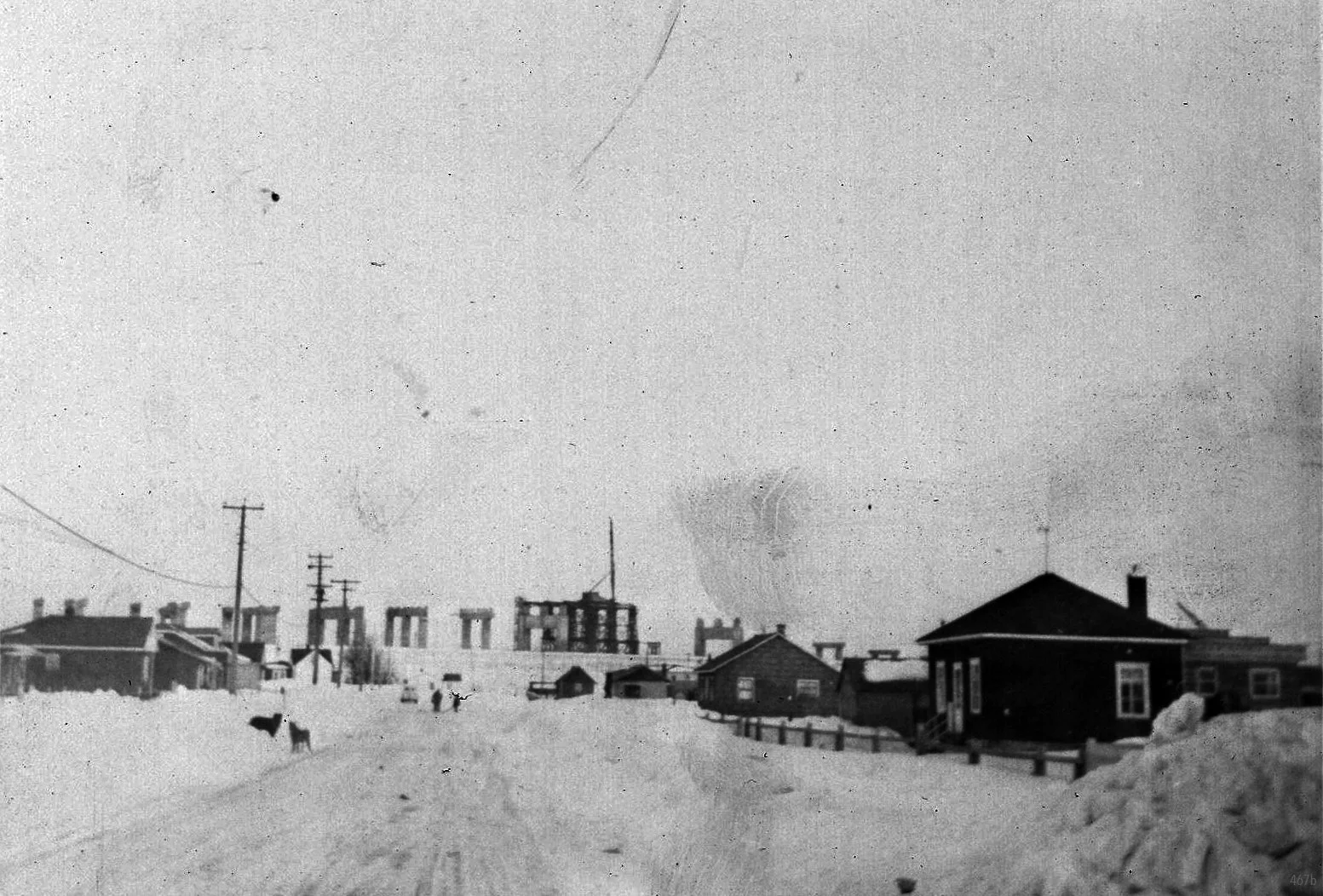Bad blast
The reconstruction of the Mercier Bridge was done at the time to accomodate the Seaway. (Courtesy: Kanien’kehá:ka Onkwawén:na Raotitióhkwa Language and Cultural Center)
Story told by Arthur Diabo
I was born in ’49 so I was about six or seven when the seaway came in. We were kids so we didn’t know much, but we heard a lot of arguments about it from our parents.
We knew that people’s houses were getting burnt down. For people who didn’t want to move, that’s what happened.
I remember when it started. There was a lot of construction and lots of trucks going back and forth every day down the main street in front of the church, starting from the hospital all the way down to the tunnel. They were hauling the rocks that they were blasting.
Those trucks drove constantly. You could time it. Every three minutes there’s a truck going down the road and with all of the dust that was created, it was really bad.
Around the back of the church and all the way up to the railroad bridge was all solid rock. They blasted all the way through there every night at six o’clock. They rang the bell and then we would hear the siren. They’re warning people that they’re going to blast.
The houses shook but we got used to that.
I remember one time there was a bad dynamite blast when they were making the seaway. Maybe they put too much dynamite but it shook the whole area and it broke the windows in most of the houses.
People were angry. There was a small uprising, but the seaway people came the next day and they replaced all the broken windows.
The thing is it was a big inconvenience for the people nearby. The seaway could have easily been built down the middle of the river or across the river on the Lachine side but instead it came through Mohawk land. It was cheaper that way. All they had to do was negotiate with us.
I’m not blaming our leaders at the time, but they could have done a better job at negotiating. But it was an international project and you don’t win those. Today, that would never happen.
KANIEN’KÉHA VERSION
↓
KANIEN’KÉHA VERSION ↓
Wahétken Wahonttatákwahte'
From the note provided by Audrey Curotte: “This must be the house Grace’s parents lived in on the farm, also I believe this was the last peace (sic) of property the “Seaway” took, Mr. and Mrs Diabo fought for their home until the bitter end.” (Courtesy: Kanien’kehá:ka Onkwawén:na Raotitióhkwa Language and Cultural Center)
Arthur Diabo ROKÁ:RATON
49 nitiohserò:ten sha'kennákerate', aktóntie ià:ia'k tóka'ni tsá:ta shitewátien' shahatina'tsherón:ni'. Tsi iakwaksà:'ahkwe', iah é:so othé:nen' teionkwaterièn:tarahkwe' nek tsi é:so wa'onkwathón:te'ne tsi wa'thonterihotahrhókhon' ne iakhiien'okòn:'a.
Ionkwaterièn:tarahkwe' tsi ratinon'kwateka'tánions nón:kwe thotinonhsó:ton'. Tsi niká:ien iah tehón:nehre' tahonná:tahkwe', kwah tho nahotiià:tawen'.
Kè:iahre' shontontáhsawen'. Nia'té:kon wahatikétsko tánon é:so ka'sérehtake ka'serehkó:wa tehonterahtánions iohahakwe'niiò:ke ohén:ton ne tsi ionterennaientáhkhwa' tsi tehshakotisniè:tha nithontahsáwha tsi niió:re tsi ken'wharatátie'. Wahatineniakaré:ni' tsi nikaneniò:tens ronattatakwáhton'.
Kwah tiokontáhkwen' wahontó:ri thí:ken'. Kwah enwá:ton enhsate'nién:tenste' tsi niiotkà:te'. Tió:konte ne áhsen' nikahseriie'takehátie' rotihaho'ktátie' iota'kenhrotátie', é:so tsi wahetkèn:ne.
Nek iotstenhrahní:ron kèn:ne ákta ne tsi ionterennaientáhkhwa kahsòn:ne tsi niió:re ne thiio'kéha waskóhon. Wa'thonnón:kohte' wahonttatákwahte' eh nón:we thia'teio'karahtsherá:ke' ià:ia'k niiohwistà:'e. Wahatihwistón:tawe'te sok enhonathón:te'ne thí:ken teiohenréhtha. Wahshakonahronkà:ten' nón:kwe' tsi ronttatakwahtà:ne.
Wa'tiononhsihsonhkwánion' nek tsi tó:kenske wa'akwarèn:nha'.
Kè:iahre' kí:ken énska wahétken wahonttatákwahte' shihotina'tsheronnihátie'. Tóka' nòn:wa sótsi é:so wattatákwas wahonnéta' nek tsi wa'tiowíhsonhkwe' tsi niwatonhóntsa tánon wa'tkatsiserahrihtánion' kanonhskónhson.
Tó:kenske wahotinà:khwen' nón:kwe. Kenk niwatenèn:ra wahonthniarón:ni' nek tsi shonsaióhrhen'ne wahón:newe' ne kana'tsherón:ni ohén:ton rón:nete' tánon wa'thatitenión:ko thí:ken tekatsiserahrihtánion ó:ia sahatitsiseratárion'
É:so tsi wa'tiako'nikonhrhá:ren' tsi niká:ien ákta ie'terón:ton', kwah nè:'e orì:wa kèn:ne. Watiesenhón:we' aiotòn:'on sha'tekaniatarí:hen' ahotina'tsherón:nike' tóka'ni ísi' na'kaniatará:ti' Skaniatará:ti' nonkwá:ti' nek tsi khé:ken' Kanien'kehá:ka raonatonhontsà:ke' wahonnétste'. Ká:ron nikanó:ronhkwe' eh nón:we'. Thok thahatí:iere' wetewatsénhaien' nì:'i.
Kwah iah tetekherá:wis nonkwakowanà:ta eh shitkahá:wi' nek tsi aiotòn:'on sénha ioiánere ahotitsenhaién:take'. Nek teiaonhontsawéhrhon' waterihwahtentià:ton' kèn:ne thí:ken tánon kwah tó:kenske ensa'shén:ni thí:ken'. Ok nòn:wa wenhniseraténion, iah nonwén:ton eh thaonsaiá:wen'.
Edited by: Melissa Stacey, Local Journalism Initiative Reporter
Translation by: Karonhí:io Delaronde


